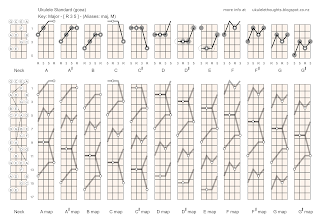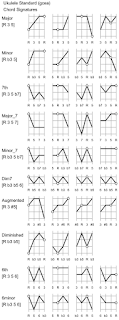Neon22
Member
- Joined
- Nov 6, 2016
- Messages
- 8
- Reaction score
- 0
I've had this idea that its much easier to learn and play chords than I've been led to believe. So I wrote an inkscape extension and lost my mind for a few weeks working it out.
Turns out - I'm pretty sure I'm right. Maybe heaps of people know this already but here's my idea. (which is in detail on https://ukulelethoughts.blogspot.com/)
1. The Problem:
Usually people learn simple chords near the neck and then are shown hundreds of chord tabs to memorise. Sigh...
2. Chord hand shapes:
Turns out every chord needs at most 4 hand shapes(fingering) to play the chord. Each shape has a root note that is the key string to remember.
Then the chords all replicate down the neck using a simple rule based on the fretboard strings (tuning).
3. Notes on the Neck:
And luckily for the Ukulele, the common tunings are GCEA, ADF#B, and DGBE - which is just the same srings shifted down the neck (2, 7 frets). (On the guitar there are many more variations of string organisation.)
So there are chord charts at the link which show all the fingerings and positions all over the neck, and also the only chart you really need. Which is the chord shapes and the Neck layout.
Here's the Major:

Here's a pile of chords:

Does anyone else think this is useful ?
Sure seems like a good way to learn them all, play them all, and its spatial reasoning based, so works well when playing IMHO...
Turns out - I'm pretty sure I'm right. Maybe heaps of people know this already but here's my idea. (which is in detail on https://ukulelethoughts.blogspot.com/)
1. The Problem:
Usually people learn simple chords near the neck and then are shown hundreds of chord tabs to memorise. Sigh...
2. Chord hand shapes:
Turns out every chord needs at most 4 hand shapes(fingering) to play the chord. Each shape has a root note that is the key string to remember.
Then the chords all replicate down the neck using a simple rule based on the fretboard strings (tuning).
3. Notes on the Neck:
And luckily for the Ukulele, the common tunings are GCEA, ADF#B, and DGBE - which is just the same srings shifted down the neck (2, 7 frets). (On the guitar there are many more variations of string organisation.)
So there are chord charts at the link which show all the fingerings and positions all over the neck, and also the only chart you really need. Which is the chord shapes and the Neck layout.
Here's the Major:

Here's a pile of chords:

Does anyone else think this is useful ?
Sure seems like a good way to learn them all, play them all, and its spatial reasoning based, so works well when playing IMHO...




